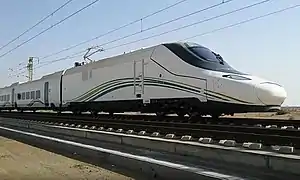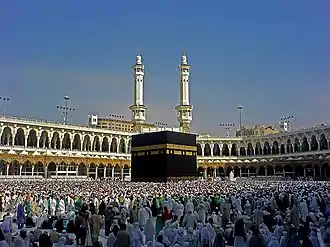Haramain High Speed Railway
The Haramain High Speed Railway (Arabic: قطار الحرمين السريع, romanized: qiṭār al-ḥaramayn as-sarīʿ, Hejazi Arabic pronunciation: [ɡɪtˤaːr alħarameːn asːariːʕ]) (Haramain referring to Mecca and Medina Islamic holy cities), also known as the Western railway or Mecca–Medina high-speed railway, is a 453-kilometre-long (281 mi) high-speed rail line in Saudi Arabia.[3] It links the Muslim holy cities of Medina and Mecca via King Abdullah Economic City and Jeddah, using 449.2 kilometres (279.1 mi) of main line and a 3.75-kilometre (2.33 mi) branch connection to King Abdulaziz International Airport (KAIA), in Jeddah.[4] The line was designed for a top speed of 350 km/h (220 mph), and with a service speed of 300 km/h (190 mph).
| Haramain High Speed Railway | |||
|---|---|---|---|
 Talgo 350 SRO during a test run | |||
| Overview | |||
| Status | Operational[1] | ||
| Termini | |||
| Stations | 5 | ||
| Website | https://sar.hhr.sa | ||
| Service | |||
| Type | High-speed rail | ||
| Operator(s) | Saudi Arabia Railways (with Adif and Renfe) | ||
| Rolling stock | Talgo 350 SRO | ||
| Ridership | 50 million per year (expected)[2] | ||
| History | |||
| Opened | 11 October 2018 | ||
| Technical | |||
| Line length | 453.0 kilometres (281.5 mi) | ||
| Number of tracks | 2 | ||
| Track gauge | 1,435 mm (4 ft 8+1⁄2 in) standard gauge | ||
| Electrification | 25 kV AC, 50 Hz Overhead catenary | ||
| Operating speed |
| ||
| |||
Construction on the project began in March 2009 and, after nine years of building, the system was officially inaugurated on 25 September 2018,[5] opening to the public on 11 October 2018.[6] Initial estimates had predicted the railway serving at least 60,000,000 passengers annually, with a minimum 3,000,000 of them being Hajj and Umrah pilgrims—the train was intended to, ideally, relieve the congested automobile traffic surrounding the holy sites and cities. It does not connect with the Mecca Metro.[7]
On 20 March 2020, the route between Mecca and Medina was suspended, and the railway system was temporarily out-of-service due to the worldwide COVID-19 pandemic. Just over one year later, on 31 March 2021, the first post-lockdown trip from Mecca to Medina was launched.[8]
History
Package 1
The 6.79 billion riyal (US$1.8 billion) design and construction contract for Phase I Package 1 – Civil Works for the project was awarded in March 2009 to Al Rajhi Alliance,[9] which comprises China Railway Construction Corporation (CRCC), Al Arrab Contracting Company Ltd, Al Suwailem Company and the French construction company Bouygues. It is cooperating with the consultant Saudi Consolidated Engineering Company (Khatib and Alami). Scott Wilson Group will provide project management support.[10]
Package 2
Phase I Package 2 covers construction of four of the five stations.[11] In April 2009, $38 million worth of design contracts for the stations in Mecca, Medina, Jeddah and KAIA were awarded to a joint venture between Foster + Partners and Buro Happold.[12][13][14] In February 2011 the station construction contracts were awarded to Joint Venture between Saudi Oger Ltd & El Seif Engineering for (KAEC (Rabigh) & Jeddah Stations), Saudi Binladin (Mecca Station) and a Turkish Company "Yapi Merkezi" for Medina Station.[11]
Phase II
Phase 2 of the project includes the remaining infrastructure not included in Phase-1: track, signalling, telecommunications, power, electrification, etc. It also includes procurement of rolling stock and operations and maintenance for a period of 12 years after completion.[3]
Prequalified consortia for HHR Phase 2 included Saudi Binladin Group, Badr Consortium, China South Locomotive & Rolling Stock, Al-Shoula Group and Al-Rajhi Alliance.[15]
On 26 October 2011, at the Saudi Railways Organization announced that the Saudi-Spanish consortium Al‑Shoula Group, which includes Talgo, Renfe, Adif, Copasa, Imathia, Consultrans, Ineco, Cobra, Indra, Dimetronic, Inabensa, OHL, AL-Shoula and Al-Rosan, had been chosen for the contract.[16][17] Talgo will supply 35 Talgo 350 trains similar to 102/112 series used on Spanish high-speed lines for EUR 1,257 billion (1,600 with maintenance) and an option for 23 more for 800 million.[18] They differ from the 112 series with 13 cars to 417 seats[3][19] Renfe and Adif will operate the trains and manage the line for 12 years.[3]
The project was originally planned to open in 2012, taking six years longer to complete than anticipated.[20] The total contract value is EUR 6.736 billion (approximately US$9.4 billion).[3][21]
Fire
On 29 September 2019, less than a year after the opening of the line, a massive fire broke out at Jeddah station.[22] The roof panels, made of fibre-reinforced plastic, caught fire due to unknown causes. Firefighters needed 12 hours to bring the fire under control. Several people were injured by the fire, which completely destroyed Jeddah station.[23] To allow train service between Mecca and Medina to resume, a 1,5 kilometer bypass was built around the station building.[24]
Design
The double-track line is electrified and the design speed is 350 kilometres per hour (220 mph).[25] Trains run in service at 300 kilometres per hour (190 mph),[9][26] and travelling the 78 kilometres (48 mi) between Jeddah and Mecca takes 43 minutes, while the 449 kilometres (279 mi) between Mecca and Medina takes about 2 hours.[27] The track, rolling stock and stations are designed to handle temperatures ranging from 0 °C (32 °F) to 50 °C (122 °F).[28] It is expected that the system will transport 60 million passengers[29] a year on 35 trains, with a seating capacity of 417 per train.[30]
Engineering
Saudi Railways Organisation commissioned Dar Al-Handasah to prepare the concept design and tender documents of the Haramain High Speed Rail (HHSR) project. Dar Al-Handasah was also assigned to the construction supervision and project management of the HHSR. Dar Al-Handasah work on the HHSR incorporates one cut-and-cover tunnel, 46 rail bridges, 9 wadi bridges, and 5 rail underpasses, 53 vehicular overpasses, 30 vehicular underpasses, 12 camel crossings, 5 stations, and 3 depots to allow the rail to fulfil the needs of its users.[31]
Trains
36 Spanish Talgo 350 SRO trains have been ordered, one of these is expected to include a Dual (hybrid) coach pair for up to 20 or 30 VIPs; they will run at 300 km/h (190 mph).[32] The propulsion and bogies were made at Bombardier factories in Spain.[33][34]
Stations
There are five stations on the line at:
- Medina Station (King Abdulaziz Street-East)
- King Abdullah Economic City Station in Rabigh
- King Abdulaziz International Airport - opened 11 December 2019[35]
- Jeddah Station (Naseem) - Operating[36]
- Mecca Station (Rusaiyfah)[37][12]
The Makkah Central Station is located near the 3rd Ring Road, in Rusaiyfah District near the Rusaiyfah park and ride to the Grand Mosque. The Jeddah Central Station is located on Haramain Road, in Al-Naseem District. The railway alignment route is on the median of the Haramain road. Medina has a passenger station. A station, connected via branch line, is built in the new King Abdulaziz International Airport.[25]
According to Saudi Railways Organisation the stations are "aesthetically iconic" buildings with designs which take into account Islamic architectural traditions. They have shops, restaurants, mosques, car parking, a helipad and VIP lounges. Stations were designed by Buro Happold and Foster + Partners.[11]
References
- "Makkah to Medina in 90 minutes: Saudi king launches new Haramain rail service". ArabianBusiness.com.
- "Testing set to begin on Saudi high-speed line". 26 November 2014.
- "Spanish consortium wins Haramain High Speed Rail contract". Railway Gazette International. 26 October 2011.
- "Maps and diagrams in Spanish. Colegio ICPP de Madrid" (PDF). Archived from the original (PDF) on 27 December 2014.
- Kalin, Stephen. "Saudi Arabia opens high-speed train linking Islam's holiest cities". U.S. Retrieved 25 September 2018.
- "Pictures: Saudi Arabia opens high-speed railway to public". GulfNews. 12 October 2018. Retrieved 15 October 2018.
- "Saudi Arabia opens high-speed rail linking Islam's holy cities". The Guardian. 25 September 2018. Retrieved 25 September 2018.
- "Saudi Arabia's Haramain train operations resume on Wednesday". Arab News. 31 March 2021. Retrieved 31 March 2021.
- "Al Rajhi wins Makkah – Madinah civils contract". Railway Gazette International. 9 February 2009.
- "Haramain High Speed Rail project manager appointed". Railway Gazette International. 6 January 2010.
- "Haramain High Speed Rail station construction contracts signed". Railway Gazette International. 16 February 2011.
- "High speed stations for a high speed railway". Railway Gazette International. 23 April 2009.
- "Foster + Partners and Buro Happold joint venture to design four stations for Saudi Arabia's new Haramain High-speed Railway". Foster and Partners. Archived from the original on 3 October 2009.
- "Joint venture to design four stations for Saudi Arabia's new high speed railway". Buro Happold. Archived from the original on 30 August 2009.
- "Phase 2". Saudi Railways Expansion Programme. Saudi Railways Organization. Archived from the original on 9 April 2016. Retrieved 26 February 2010.
- "ADIF participation in phase 2". Archived from the original on 8 January 2011. Retrieved 29 May 2011.
- "Adjudicado al consorcio español el contrato de alta velocidad en Arabia Saudí" (in Spanish). Retrieved 26 October 2011.
- "Talgo se adjudica el contrato de Arabia. Patentes Talgo". Archived from the original on 29 November 2014. Retrieved 3 December 2014.
- "Page 188 Mario Oriol from Talgo in UIMP Seminary" (PDF).
- "Saudi high-speed train links holy cities". BBC News. 25 August 2018. Retrieved 25 September 2018.
- "Un consorcio español logra el AVE La Meca-Medina por 6.736 millones". Europa Press (in Spanish). 26 October 2011.
- "Fire engulfs new Saudi high-speed rail station in Jeddah | DW | 29.09.2019". www.dw.com. Retrieved 7 October 2020.
- "Jeddah station fire: Why were people on the roof?". al-bab.com. Retrieved 7 October 2020.
- "Haramain launches Jeddah airport service at 300 km/H". www.railwaygazette.com. Retrieved 7 October 2020.
- "Project brief". Saudi Railways Expansion Programme. Archived from the original on 18 December 2009. Retrieved 20 January 2010.
- "Proyecto Meca-Medina Asamblea de la PTFE" (PDF). Archived from the original (PDF) on 27 June 2012.
- "Train Schedule". www.hhr.sa. Haramain High Speed Rail. Archived from the original on 19 October 2018. Retrieved 18 October 2018.
- "Haramain High Speed Rail Project, Saudi Arabia". railway-technology.com. Net Resources International, a trading division of SPG Media Limited. 2010. Retrieved 27 February 2010.
- "Saudi Haramain Train to Start Service in September". Al Bawaba. 8 May 2018. Retrieved 9 July 2018.
- "KSA's Haramain train speeds toward a 2018 opening". Arab News. 16 March 2018. Retrieved 9 July 2018.
- "Dar Al-Handasah - Work - Haramain High Speed Rail (HHSR)". www.dar.com. Retrieved 11 December 2017.
- "Train manufacturer and supplier for the Haramin project".
- "Bombardier to supply components for Haramain High Speed Rail trains". Railway Gazette International. Retrieved 24 September 2012.
- 4-traders. "Talgo : Haramain high-speed train ready for launch | 4-Traders". Retrieved 9 July 2018.
- "Jeddah airport linked to reopened Haramain high-speed line". 11 December 2019. Retrieved 11 December 2019.
- "Jeddah Sulaymaniyah Haramain station resumes operation today". 13 July 2021.
- "Phase 1 (Package 2) – Stations". Saudi Railways Expansion Programme. Saudi Railways Organization. Archived from the original on 26 December 2009. Retrieved 26 February 2010.
External links
- Official Website
- Saudi Railways Organization
- Haramain Saudi-Spanish Alliance (in Spanish)
- Haramain High Speed Rail Project video
- Makkah Central Station Project video

